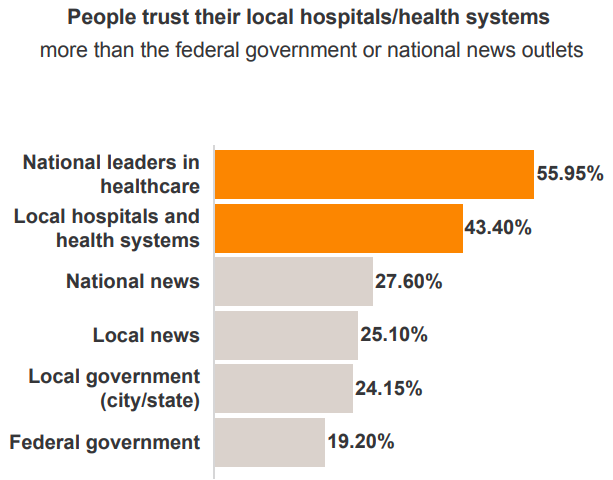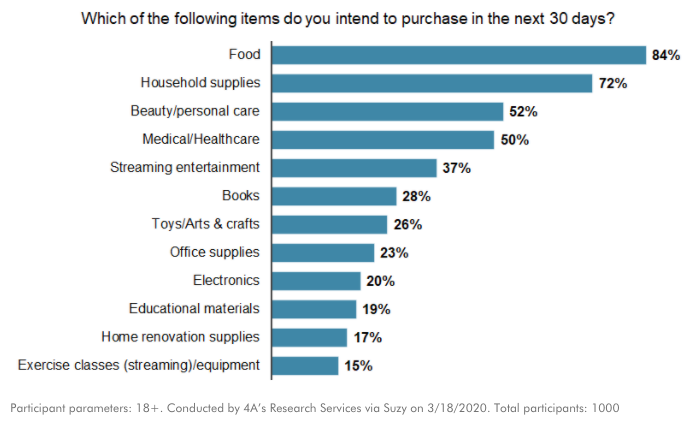
Depending on the size and scale of your organization, COVID-19 has either consumed every ounce of your focus (and energy) or had a less dramatic impact, like creating time pressures and resource constraints for your current initiatives to meet existing patient demand.
Here at True North Custom, we’ve seen a mix of both situations and we are committed to guiding clients on how to effectively tailor content and campaigns to ensure the health of their communities and organizations.
Considering the caveat that no two healthcare organizations are alike, there are several reasons that we—along with thought leaders like Atrium Health Senior Medical Director of Population Health Zeev Neuwirth, MD—see marketing as a linchpin during challenging times like these.
To illustrate, here are a few key reasons why we recommend that healthcare organizations maintain a meaningful, consistent brand and outreach strategy to generate favorable outcomes now and into the future.
The demand for online healthcare content has been on the rise for several years and has now exploded, with the majority of U.S. households working and educating their children from home. This is creating a surge of up to 50% more Internet traffic than the same period last year, and hospital and health system websites are among the most trusted sources of information on coronavirus as illustrated in the chart below from a recent NRC Health study.

By engaging these consumers with healthcare content that educates them on COVID-19 issues, eases their anxiety and encourages them to take the most appropriate actions, your brand can create affinity that lasts long after the pandemic has passed.
That grandmother who needs a hip replacement, the father preparing for weight-loss surgery and a mom stressing out about her non-malignant tumor are certainly concerned about COVID-19—and still seeking to address the physical and/or emotional pain caused by their health issues.
It's imperative that healthcare organizations stay connected to these consumers, as demand will only grow as supply is constrained. In fact, a survey of 1,000 consumers on their sentiment during COVID-19 found half (50%) are planning to purchase healthcare services in the next 30 days.

Rather than pausing campaigns promoting these and other non-COVID services, we recommend adjusting content and calls to action to acknowledge the situation and secure their place in line. For example, people who convert on a form promoting specialty appointments can receive a message to the effect of, "We're not accepting new patients right now, but please provide your contact information and we'll reach out as soon as we can to schedule an appointment."
This allows your organization to collect information from these candidates, expedite their treatment and enhance their overall patient experience now and when restrictions are loosened and capacity becomes available.
In the near term, telehealth and other virtual care options are expanding to address immediate health needs and reduce risk of COVID-19 infection. Longer term, your organization needs a strategy for scaling and promoting these services as consumers get accustomed to seeking a medical diagnosis via screen—and offering a frictionless experience becomes their baseline expectation.
Of course, the spike in demand for virtual care is causing many systems to experience capacity issues so the immediate needs are more likely related to operationalizing the technology and training on coding requirements. However, now is the time to think strategically about how to position your organization as the best choice for care in the setting that's right for your consumers.
Whether your favorite adoption curve aphorism is "the toothpaste is out of the tube" or "the genie is out of the bottle," there's typically no turning back once people get comfortable with more advanced technology.
To facilitate virtual care initiatives during the pandemic, we recommend pointing urgent care patients to telehealth as an alternative to in-person visits, as well as redirecting top-of-the-funnel conversions for priority service lines. For example, someone who is researching for same-day surgery options and downloads a guide can be directed toward a COVID-19 updates landing page that highlights the organization’s current policies with a call to action to sign up for weekly email updates on the evolving situation.
A clear view of brand perception, consumer preferences, geographic market dynamics and other metrics still matter—and will be even more important when the dust settles. Revenue growth was the top priority before the crisis, and rebounding from the financial impact of COVID-19 will be paramount as the virus dissipates and healthcare organizations compete for pent-up demand.
Marketing has a unique vantage point into these strategy drivers and other areas that can inform decisions. Keeping your team informed and clarifying misinformation during the crisis is critical, and will ensure the most effective investments and other strategic initiatives for long-term success
The “we’re in this together” mindset is permeating throughout healthcare, and maintaining team morale is critical to meeting expectations from all stakeholders, including patients, consumers, physicians and board members during the crisis.
Your organization’s messaging strategy and active presence on the website, social media and other platforms should celebrate those going above and beyond to care for the community. Blog and social posts focusing on Healthcare Heroes are seeing engagement rates higher than others, reflecting a sense of community that your content can help foster through stories of sacrifice and hope.
Either way, now is not the time to scale back and shrink away from your audience. Notwithstanding financial emergencies, a short-term response to cut a revenue-generating function sends a message that community outreach and patient acquisition aren't priorities—and that could have lasting impact beyond the COVID-19 crisis.
We propose taking a strategic approach to pivoting your marketing initiatives that reflect the realities of the day, without compromising the brand perception and revenue growth opportunities of tomorrow.
Our healthcare marketing experts can share insights and best practices based on partnerships with organizations like yours.
True North is your expert healthcare marketing agency, offering full-service, HIPAA-compliant marketing solutions.
Learn how to plan and implement a modern healthcare marketing strategy that delivers improved financial performance and elevates your role within the organization.Prior to the pandemic, ...read more
The discipline of healthcare marketing continues to progress at a rapid pace. This is perhaps best illustrated by strategic plans and budgets that increasingly reflect lower (or no) ...read more
Get more out of your custom healthcare magazine with an integrated content marketing strategy approach.If you already publish a custom magazine, congratulations: You’re ahead ...read more
Google has historically been considered a “digital backyard” where brands connect with customers; however, the dominant search engine is slowly closing the gates by claiming ...read more